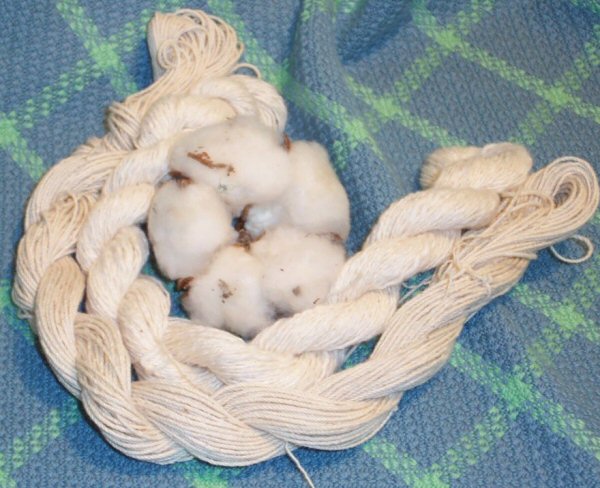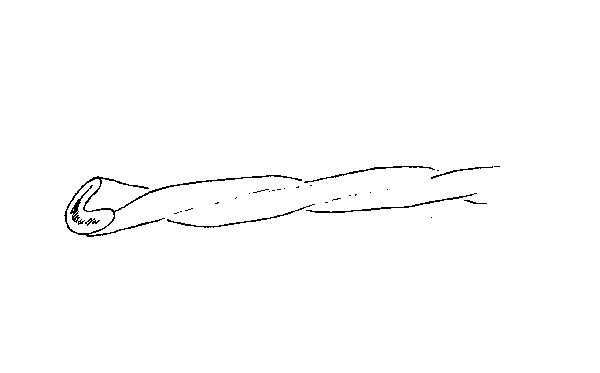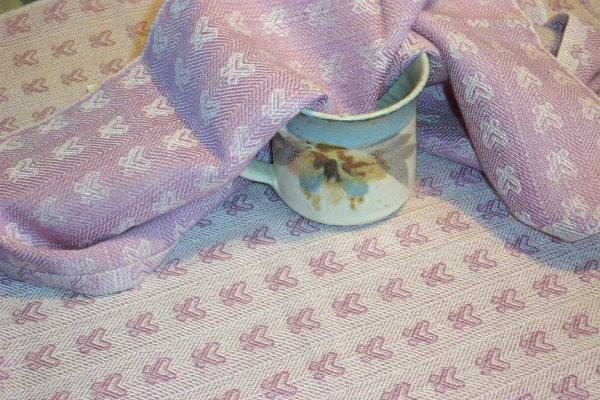It is my belief that in order to make good choices, we need to know as much about our materials as possible. In general, industry does not set out to make “bad” yarn, but as weavers we may make poor choices when we select the yarn from which we weave our cloth. Knowledge about the inherent characteristics of the fiber and how that fiber is prepared for and spun will assist us in designing cloth suitable for our intended purpose. Let’s take a closer look at cotton.

Where cotton fiber comes from and how we prepare it
Cotton fiber comes from the seed pod (or boll) of the cotton plant. It is classed as cellulosic (i.e. primarily cellulose) and the fiber length for yarn can range from short (.75” or 1.9 cm) to long (2.5” or 6.35 cm). Generally speaking, shorter fibers make a weaker yarn than longer fibers.
Some varieties of cotton commonly used are Egyptian, Sea Island and Pima. These are among the longer staple varieties and are considered to be of a quality suitable for clothing and other fine fabrics.
Once harvested, the fibers are cleaned. The seeds need to be removed from the fiber before it is spun. The fibers can then be carded or combed. The harvested fiber is a flat “ribbon’”with a slight twist in it.

Inherent characteristics of cotton fiber
The following characteristics apply to the fiber before spinning. Preparation for spinning and the type of spinning method used can moderate or enhance the characteristics of the fiber.
The strength of cotton fiber is high with good flexibility. This means that it can take repeated bending without causing damage to the fiber. However, cotton fiber has low elongation with poor recovery. Once stretched, it may not go back to its original length. Being a cellulose type fiber, density is high and absorbency is high.
One of the characteristics of cotton fiber that can be greatly affected by fiber preparation and spinning is that of absorbency.
In order to absorb water, the fiber swells. If the fibers are packed very tightly together, for example, combed so that the fibers lay parallel to each other, absorbing water becomes more difficult because there is no room for the fiber to swell. If the parallel fibers are also given a tight twist, it becomes even more difficult for the yarn to absorb water.
If you have ever worked with cotton seine twine, you will know that this yarn is incredibly strong, very dense and not very absorbent. This yarn has been engineered and manufactured to be used for making fishing nets, so it must hold a lot of weight, withstand a great deal of abrasion and reduce absorbency, which would increase the weight of the net significantly.

Spinning cotton fibers
Cotton fibers, like wool, can be spun in a tangled mass or in a parallel alignment. According to J. J. Pizzuto’s Fabric Science, there are also two different types of spinning commonly used: open-end and ring spun.
For open-end spinning “Carded sliver is fed to the open-end spinning unit, which separates the fibers, twists them together to form the completed spun yarn and then winds the yarn onto spools or cones.” The advantages of open-end spinning are “better regularity and uniformity; improved abrasion resistance, especially in high twist types, improved distribution of fibers in blends and improved absorption.” The disadvantages are “yarn strength averages 20 percent lower than conventionally spun yarns (ring spun) and manufacture is limited to coarse and medium-size yarns.”
Ring spinning closely resembles spinning done with from roving or sliver. In this case, the sliver is drafted using a series of rollers to bring it to the appropriate size for the yarn being made. Twist is added and the yarn carried through a ring (flyer) that winds the spun yarn onto a spindle.
After spinning, cotton can be mercerized. The process of mercerization introduces the yarn (or woven fabric) to a solution of cold concentrated sodium hydroxide (lye) while under tension. The process of mercerization increases cotton’s strength by nearly 25 percent, improves dye affinity and enhances fabric hang and drape.
Yarn can also be singed by passing the yarn through a gas flame, which will reduce the bits of fiber sticking out of the yarn, making the yarn smoother and more lustrous.
Affecting the fiber characteristics
We can also affect the fiber characteristics by how we weave our cloth. We can use a yarn that is less sturdily built than seine twine and still create a very dense cloth that will withstand abrasion and be less absorbent by increasing the number of threads per inch and using the maximum number of interlacements.
In other words, using exactly the same yarn, weavers can create cloth of different characteristics by increasing or decreasing the number of ends per inch and/or picks per inch as well as through the weave structure they choose. Plain weave has the maximum number of interlacements; twill has fewer, and so on.
Other characteristics are revealed through a burn test. Cotton fiber has a fairly low resistance to heat at 300 F or 150 C. Once alight, it burns quickly and will continue to burn after being removed from the flame. The odor will be similar to burning paper and the residue will be a light fluffy ash.
A cotton cloth that is woven very densely with the maximum number of interlacements will resist burning longer than a loosely woven cloth.
Cotton Characteristics Review
- Strength – High
- Flexibility – Good
- Elongation – Low
- Recovery – Poor
- Density – High
- Absorbency – High
Burn Test
- Heat Resistance – 300 F/150 C
- In Flame – Burns quickly
- Removed – Continues to burn
- Odor – As of burning paper
- Residue – Light, fluffy ash
Cotton fiber is a versatile choice for craftspeople. It can be used to make everything from clothing to a wide range of household textiles.

Share tips, start a discussion or ask one of our experts or other students a question.
No Responses to “Everything You Need to Know About Cotton Fiber”